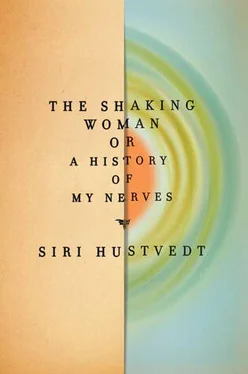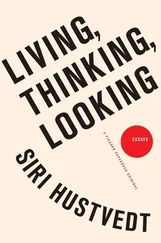LeDoux’s work recalls Pavlov’s famous conditioning studies with dogs. The difference is that through similar training and with new tools, he has identified parts of the essential fear routes in the brain, involving, in particular, a small almond-shaped part of the limbic system called the amygdala, which is also involved in the consolidation and reconsolidation of emotional memories. To my mind, it is absurd to say that the rat isn’t conscious of the tone and the shock. The rat is alive, awake, and remembering. What he doesn’t possess is the highest level of human self-consciousness. He no doubt has some kind of me-ness, a subliminal sense of his own organism and its drives to fight, play, flee, have sex, and eat, and he surely recognizes his fellow rats and can distinguish them from predators. He does not have an internal narrator telling the story of his adventures in the lab with those gargantuan scientists in white coats delivering tones and unpleasant bursts of electricity.
Shaking looks like a fear response, one of “the somatic manifestations of anxiety.” “He was trembling with fear” is a cliché. The sound of thunder would send the border collie of my childhood, Balder, running to his bed, where he would become a trembling lump of black-and-white fur. When I’m crossing the street and a car unexpectedly turns into the crosswalk, I always freeze momentarily before rushing out of the way, but even when I respond instantly, before I am fully aware of my fear and its object, I feel my heart beating and my lungs tighten. On the day my convulsions began, I had no awareness of either the object of my fear or the normal signs of fear. I felt the shaking but had no way to identify it as anything . I want to stress that at the time, rather stupidly, it never occurred to me that it would happen again. I was convinced that it was a singular event and, as such, I was able to regard it with fascination rather than alarm. Having to speak in public has become my tone or clap of thunder, and if there is a memory involved, it is implicit, not explicit, and the shaking itself doesn’t involve my higher self-reflexive consciousness. But talking and thinking and staying calm do. In order to keep talking, despite my shaking, I have to use a part of my brain that can, in fact, regulate fear — the medial and ventral prefrontal cortex. LeDoux argues, “Pathological fear, then, may occur when the amygdala is unchecked by the prefrontal cortex, and treatment of pathologic fear may require that the patient learn to increase activity in the prefrontal region so that the amygdala is less free to express fear.” 117He further argues that the relation between the amygdala and the prefrontal region is reciprocal — that is, if one is turned on, the other is inhibited. But that is not what happened to me. I talked and shook, although in the end, some part of me seemed to be able to put a lid on the blasting alarm coming from down under. On the other hand, perhaps my feeling of control was an illusion.
In my case, two systems appear to be entirely cut off from each other initially, until the regulator takes hold. Still, as scientists like to say, correlation is not cause. Maybe the two things have nothing to do with each other. And why I shook the first time remains mysterious. The first event is significant, because neural networks are sensitive and, once formed, are prone to repetition. In neuroscience, one of the first ideas I learned, no doubt made memorable by the convenient rhyme, was Hebb’s law: “Neurons that fire together wire together.” The more I shake, the more likely it is that I’ll shake in the future. Can I say that the shaking woman is a repeatedly activated pattern of firing neurons and stress hormones released in an involuntary response, which is then dampened as I keep my cool, continue to talk, convinced that I am not really in any danger? Is that all there is to the story?
In his book The Astonishing Hypothesis, Francis Crick, who, with James Watson, discovered DNA, explained his title: “You, your joys and your sorrows, your memories and your ambitions, your sense of personal identity and free will are, in fact, no more than the behaviour of a vast assembly of nerve cells and their associated molecules.” 118Crick may indeed be expressing a truth, but there’s something wrong with his formulation nevertheless. Would anyone deny that Tolstoy’s “The Death of Iván Ilých” is paper and ink or that Giorgione’s The Tempest is canvas and paint? And yet, how far does that get us in expressing what these works are? Am I wrong in feeling that “a vast assembly of nerve cells” is an inadequate description of me or that those words fail to answer the question, What happened to me? Am I looking for a narrative, a confabulation, to interpret a debility that is no more and no less than synaptic wiring and firing? Joseph LeDoux is less of a reductionist than Crick. He acknowledges that there are levels of human reality. Revealingly, he puzzles over the question Freud asked in 1895, as he worked on his Project, the same question the conversion researchers asked, the two men who found themselves translating J. Russell Reynolds into updated language more than a century after his lecture. LeDoux writes, “The problem is that it is not clear how the changes at the neural level relate to those at the psychological level.” 119There’s the rub.
LURIA’S S. SEEMED TO TRANSLATE all of his experience into visual form. I seem to translate everything into bodily feelings and sensations. Several years ago, I received a letter from a person who belongs to an international synesthesia organization. She had read my books and become convinced that I had it . My knowledge of the phenomenon was shallow at the time, and I wrote back saying that numbers and letters weren’t colored for me and left it at that. What she didn’t say is that there is something called mirror-touch synesthesia, which is when a person feels another person being touched or in pain simply by looking at him or her. 120But then this form of synesthesia wasn’t described or named until 2005. When I was a child, my mother used to tell me that I was “too sensitive for this world.” She didn’t mean it unkindly, but for many years I chalked up my hypersensitivity to a character flaw. For as long as I can remember, I have felt the taps, knocks, and bumps, as well as the moods, of other people, almost as if they are mine. I can tell the difference between an actual touch and the one I feel when I look, but the sensation is there nevertheless. I feel the sprained ankle of someone else as a pain in my own. Watching a mother caress a child gives me the physical pleasure I would give or take from the same gesture. If someone is being hurt in a movie, I must close my eyes or head for the exit. As a girl I spent half of every episode of Lassie in the bathroom. Violent movies and horror films are intolerable to me because I feel the victim’s torture. Looking at or even thinking about ice or an ice cube makes me shiver. My empathy is extreme and, to be frank, I sometimes feel too much and need to protect myself from overexposure to stimuli that will turn me into a pillar of aching flesh. All of this is apparently typical of people with mirror-touch synesthesia.
I also have powerful feeling responses to colors and light. For example, during a trip to Iceland, I was in a bus looking out the window at that extraordinary treeless landscape when we passed a lake that had an unusual color. Its water was a glacially pale blue-green. The color assaulted me as if it were a shock. It ran up and down my whole body, and I found myself resisting it, closing my eyes, waving my hands in an effort to expel that intolerable hue from my body. My traveling companion, sitting beside me, asked me what was wrong. “I can’t bear that color,” I told her. “It hurts me.” Under standably, she was surprised. Most people aren’t attacked by colors. Various kinds of light create distinct emotions in me: the balm of afternoon sun through a window, the irritant of dim streetlights, the cruelty of fluorescence. Luria quotes S. as saying, “When I ride the trolley I can feel the clanging it makes in my teeth.” 121Noises often affect my teeth. A sound knocks them or burns in them or buzzes through my gums. Perhaps this is ordinary. I don’t know. If I look at too many paintings (and I love paintings), I become dizzy and nauseated. This affliction also has a name: Stendhal syndrome. But in me, at least, it is related to migraine and can develop into a full-blown headache.
Читать дальше












